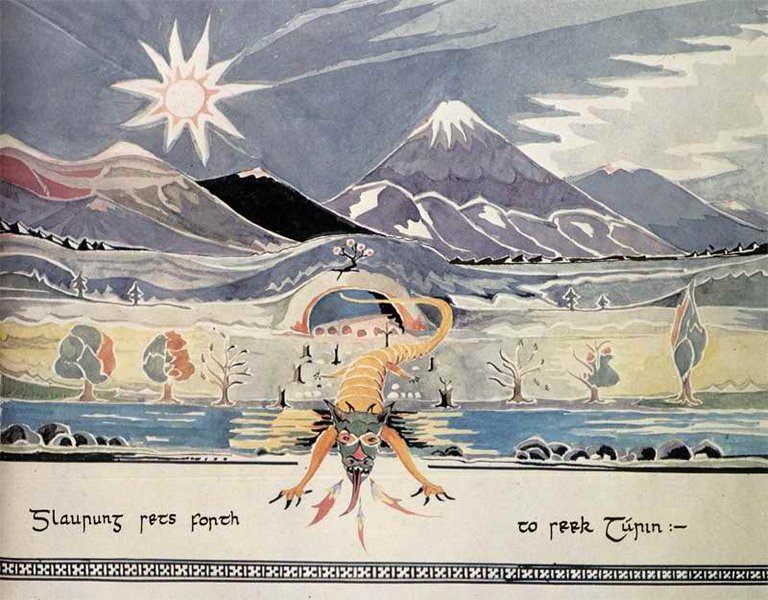What types of dragons are there in Middle-earth and how and why do they differ?
-
I'll edit it out.– MachinaMandalaCommented Apr 21, 2017 at 10:32
-
4I recommend you flesh out your question a bit more in the body. This will not only attract more attention but will show you've thought about this question slightly more than it just popping into your head.– EdlothiadCommented Apr 21, 2017 at 10:57
-
8What research have you done to try to answer this yourself?– curiousdanniiCommented Apr 21, 2017 at 13:54
2 Answers
There were Fire-drakes and Cold-drakes
The first fire-drake to issue from the gates of Angband was Glaurung; he was said to have sired the other fire-drakes and they are also the most common.
Again after a hundred years Glaurung, the first of the Urulóki, the fire-drakes of the North, issued from Angband’s gates by night.
The Silmarillion
The only mention of cold-drakes that I could find was in the appendices of Return of the King:
At last Dáin I, together with Frór his second son, was slain at the doors of his hall by a great cold-drake.
Return of the King - Appendix A
Some of the Dragons were wing-less, such as Glaurung; these were often described as worms came in two types, the long-worms and were-worms:
“Of his son, Fram, they tell that he slew Scatha, the great dragon of Ered Mithrin, and the land had peace from the long-worms afterwards.”
ibid
The only mention of were-worms comes in The Hobbit, and whether or not they actually are Dragons is questionable.
“Tell me what you want done, and I will try it, if I have to walk from here to the East of East and fight the wild Were-worms in the Last Desert.”
The Hobbit - "An Unexpected Party"
This is everything I can think of right now, will come back and edit though
A drawing of Glaurung done by Tolkien
-
3There's speculation that Long-Worms and Were-Worms were in fact one and the same thing, and that Hobbits just called Long-Worms by a different name, as they did so many things. Commented Apr 21, 2017 at 13:37
-
2Though to counter my own argument, the Hobbit Trilogy movie (if you regard it as a legitimate source of information) actually depicts Were-Worms as their own, sort of giant Earthworm species, the great "Earth-Eaters" of old. No other source corroborates this, which is why there is speculation that Were-Worms either do not exist or were some other creature. Commented Apr 21, 2017 at 13:45
-
The etymology of were-worm, if modelled on were-wolf is "man-dragon" (or mandrake? From Old English, "wer" means adult male.– James KCommented Apr 21, 2017 at 21:22
-
What’s your reasoning for understanding “worms” to refer just to the wingless ones? There’s lots of precedent in mythology for “worm” being used for winged dragons; and in Tolkien’s Farmer Giles of Ham, the winged dragon Chrysophylax frequently gets referred to as a worm (and not just in insult by Giles).– PLLCommented Apr 22, 2017 at 10:09
-
Perhaps obvious to some, but I think the answer would be better if you explained what makes a dragon a "fire-drake" and what makes one a "cold-drake".– WyrmwoodCommented Apr 16, 2020 at 18:08
There were two general kinds, the Fire-drakes and Cold-drakes, as well as winged and unwinged dragons.
The first dragon encountered in the First Age was Glaurung. Whether he was the father, in terms of breeding, or the first created is unclear. Other fire-drakes are mentioned in the various battles of the First Age in The Silmarillion. Glaurung is eventually slain by Túrin, but not before he created considerable mischief. He was a speaking dragon. It is unclear if all fire-drakes could speak.
Again after a hundred years Glaurung, the first of the Urulóki, the fire-drakes of the North, issued from Angband’s gates by night.
The Silmarillion
During the last battle in The Silmarillion, when Morgoth was defeated by the intervention of the Valar into Middle-earth, Eärendil the Mariner with the Silmaril on his brow fought and defeated Ancalagon the Black, a winged dragon. The battle took place in the sky.
In later ages other dragons are mentioned, though I can't find a reference for a dragon in the Second Age.
In the Third Age, a cold-drake slew a famous dwarven King, as noted in the first appendix of the Lord of the Rings (Return of the King).
At last Dáin I, together with Frór his second son, was slain at the doors of his hall by a great cold-drake.
A hero of the people who later became the Rohirrim slew a dragon.
Of his son, Fram, they tell that he slew Scatha, the great dragon of Ered Mithrin, and the land had peace from the long-worms afterwards.”
Appendix A, Return of the King
In The Hobbit, Smaug the flying, fire-breathing dragon is eventually slain and his horde looted, although some years before he had destroyed both Dale and the dwarven kingdom in Erebor. He is called "Smaug the Golden" by Bilbo at one point.
Gandalf, in The Lord of the Rings, mentions that of the seven rings of the dwarven kings, some were devoured by dragons but the details are sketchy regarding which ones and where.

